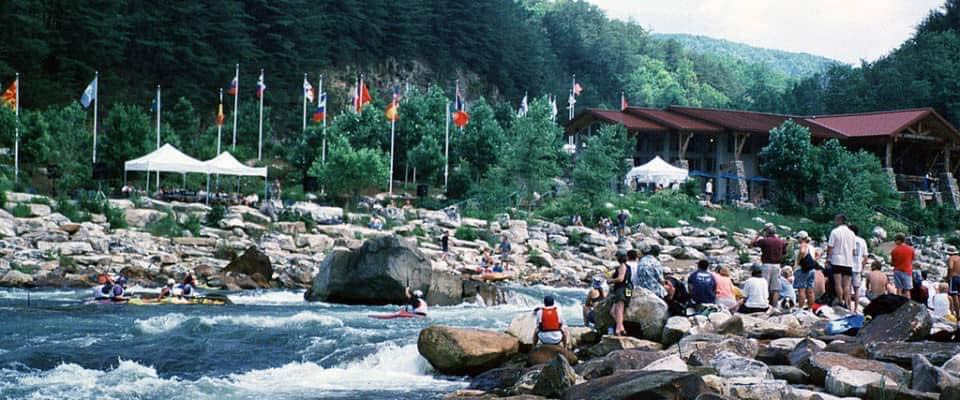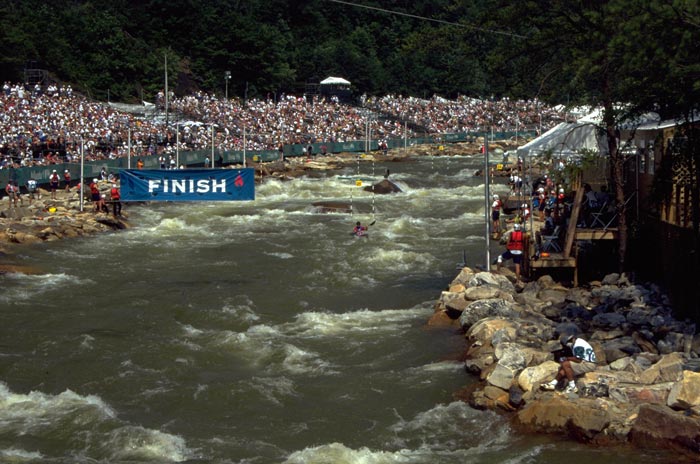Ocoee River Corridor
1996 Olympics - Whitewater Kayak & Canoe Slalom
Why the Ocoee River for the 1996 Olympics?
Picture a river that blends nature’s raw power and untamed beauty and beckons with its thundering rapids, rocky terrain, and stunning surroundings. The Ocoee River is precisely that – a force to be reckoned with, yet captivating in its allure.
One of the most important historical moments that happened on the Ocoee is the 1996 Olympic Games. This monumental decision to turn our natural river into the site for the kayak and canoe slalom events was unprecedented and put the Ocoee River on the world map as a top rated river for rafting.

First Natural Olympic River!
Kayak and canoe whitewater slalom is where athletes use two types of boats: canoes or kayaks. In the canoe events, paddlers kneel with a single blade paddle. In the 1996 Olympics, the canoe events were only open to men. In the kayak events, which in 1996 were open to both men and women, the athlete sits with legs in front and utilizes a double-bladed paddle. Then, athletes in each event must navigate a maximum 25 upstream and downstream gates as quickly as possible. There are double and single canoe events, and single kayak events.
The Upper Ocoee River boasts Class III and IV rapids, which ensured an exhilarating ride for Olympic athletes that demanded precision and agility. Also, accessibility was crucial in selecting this river as the venue for canoe slalom during the 1996 Olympics. Located near Atlanta, the host city of those summer games, it offered easy access for competitors and spectators.
Additionally, environmental sustainability was paramount in choosing the location. The Ocoee River presented a unique opportunity to showcase how sports events coexist harmoniously with nature without leaving behind lasting damage or ecological footprints.
Intriguingly intricate yet undeniably picturesque, it was no wonder Olympic officials were captivated by what the Ocoee River had to offer. Its rugged charm combined with practicality made it an obvious choice for hosting one of history’s most memorable whitewater events. The river only required minor adjustments from the event coordinators for this historic event. The 1996 Olympics cemented the Ocoee River as the only natural river used in an Olympic event in the world. Previously, Olympic river events were 100% man-made.
The Ocoee River's 1996 Olympic Whitewater Events
Athletes from 30 nations met enthusiastic fans at the bank of the Upper Ocoee River as they prepared to navigate the challenging rapids during the canoe slalom event in pursuit of Olympic gold.
Over 100 countries competed during the canoe and kayaking events, thus leaving a lasting legacy for future generations. The whitewater center built specifically for these Olympic Games had continued to attract paddlers from all corners of the globe who seek adventure on its exhilarating rapids until the center burned down on April 26, 2022.
Now, visitors can recreate the thrill of the 1996 Olympics by rafting the Upper Ocoee River. Select an Ocoee River permitted, commercial rafting outfitter and experience the excitement yourself.

The Ocoee River Olympic course in use.
Image courtesy of United States Forest Service.
What Makes the Ocoee River So Special as an Olympic Venue
1996 Olympic Whitewater Kayak and Canoe Racing Results
Europe Dominates, USA Wins Silver, Hometown Athletes Inspire
Germany dominated the 1996 Olympics kayak and canoe slalom events by winning gold medals in both the men’s K-1 and women’s K-1 categories, thanks to Thomas Schmidt and Elisabeth Micheler-Jones. The men’s C-1 gold was claimed by Czech paddler Lukáš Pollert, while France’s duo of Frank Adisson and Wilfrid Forgues secured the gold in the men’s C-2 event.
The US team made the winner’s podium thanks to Dana Chaldek, who secured the silver medal in the women’s K-1 competition. The US team knew the area well, as most members trained on the Ocoee and nearby Nantahala rivers. What an incredible accomplishment to compete in the highest level of canoe and kayak slalom racing that whitewater athletes can reach!
| USA Mens and Womens Kayak and Canoe Team SLALOM | |
|---|---|
| Men's Kayak (K-1) | Women's Kayak (K-1W) |
|
Scott Shipley Poulsbo, Wa.
Rich Weiss Atlanta, Ga. |
Dana Chladek Kensington, Md. Cathy Hearn Garrett Park, Md. |
| Men's Canoe (C-1) | Men's Double Canoe (C-2) |
|
Adam Clawson Bryson City, N.C. David Hearn Bethesda, Md. |
Wayne Dickert Bryson City, N.C. Horace Holden Bryson City, N.C. |

How the Ocoee River Got in the 1996 Atlanta Olympics
The Local Tennessee community worked hard to make the Ocoee River the site for the 1996 Olympic slalom events. Cleveland County, Polk County, Fannin County, representatives from area outfitters, and other key community folk rallied to convince IOC that the Ocoee River was the best option and they could build the course. This was a huge win for our community and one we’re proud of to this day!
Building the Ocoee River Olympic Whitewater Course
The Ocoee Olympic course updates were a joint venture between the Tennessee Valley Authority (TVA), U.S. Forest Service, and Atlanta Committee for the Olympic Games (ACOG). John Anderson, a renowned designer of many whitewater courses around the world, spearheaded the challenge of molding the Upper Ocoee River into a formidable Olympic-level course.
This 500-meter course consisted of 25 gates and was twice the length of the Lee Valley course used in the 2012 London Olympics. The pièce de résistance of the course is the aptly named rapid “Humongous,” which is the steepest and most constricted rapid on the river.

See full size map sourced from Wikipedia.
Map of the Ocoee River Olympic slalom course, with gates and named rapids identified:
- Best Ledge, the drop above Olympic gate #1;
- Smiley’s, where a midstream boulder splits the stream below gate #3;
- Slam Dunk, the ledge between gates #8 and #9;
- The Conveyor Belt wave train, gates #10 – #17;
- Callihan Ledge at gate #18;
- Humongous, gates #21 – #24.
Find Your Upper Ocoee "Olympic" River Rafting Trip here!

The Ocoee Whitewater Center: Olympic Headquarters
Along with the updates to the riverbed, the local government also put money into giving the Upper Ocoee a facelift that could withstand the thousands of fans that would show up for the events and visit this historic sight for decades to come. This included the Ocoee Whitewater Center, a beautiful building to celebrate the 1996 Olympics. Tragically, this building burnt down in 2022, but the local government is working to update and reopen this center as a new community center in the coming years.
History of Olympic Whitewater Kayak and Canoe Slalom Since 1972
Munich in 1972 was the very first Olympic games to host canoe and kayak slalom events. However, we had to wait another 20 years (Barcelona in 1992) to see these events in the games again. The US team had a big win with Joe Jacobi and Scott Strausbaugh winning gold in Men’s C-2, while our local Wonder Woman Dana Chladek won bronze in Women’s K-1.
Atlanta was the third Olympic Games ever to host Canoe and Kayak Slalom events on the Ocoee River with the first-ever natural river Olympic course, and the games kept slalom as an event in every summer Olympics since.
To this day, the Ocoee and Nantahala rivers are producing formidable Olympic athletes, with our local stars like Evy Leibfarth competing in the 2020 and 2024 games!

